Komárno
Komárno (Hungarian: Komárom, colloquially Révkomárom, Öregkomárom, Észak-Komárom, German: Komorn, Serbian: Komoran/Коморан) is a town in Slovakia at the confluence of the Danube and the Váh rivers. Komárom was formed from part of a historical town in Hungary situated on both banks of the Danube. Following World War I and the Treaty of Trianon, the border of the newly created Czechoslovakia cut the historical, unified town in half, creating two new towns. The smaller part, based on the former suburb of Újszőny, is in present-day Hungary as Komárom (the historical Hungarian town had the same name). Komárno and Komárom are connected by the Elisabeth Bridge, which used to be a border crossing between Slovakia and Hungary until border checks were lifted due to the Schengen Area rules.
Komárno Komárom | |
|---|---|
Town | |
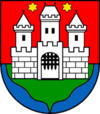 Coat of arms | |
 Komárno Location in Slovakia | |
| Coordinates: 47°45′48″N 18°07′42″E | |
| Country | Slovakia |
| Region | Nitra |
| District | Komárno |
| First mentioned | 1075 |
| Government | |
| • Mayor | Béla Keszegh |
| Area | |
| • Total | 102.807 km2 (39.694 sq mi) |
| Elevation | 110 m (360 ft) |
| Population (2018-12-31[1]) | |
| • Total | 33,927 |
| • Density | 330/km2 (850/sq mi) |
| Time zone | UTC+1 (CET) |
| • Summer (DST) | UTC+2 (CEST) |
| Postal code | 945 01 |
| Area code(s) | +421-35 |
| Car plate | KN |
| Website | www.komarno.sk |
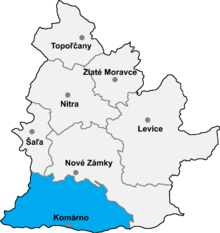
Komárom is Slovakia's principal port on the Danube. It is also the center of the Hungarian community in Slovakia,[2] which makes up 53.8% (2011 census) of the town's population. The town is the historic seat of the Serbian national minority in Slovakia.[3][4]
Names and etymology
The name is of Slavic or Latin origin. The first interpretation is straightforward – the name consists of two parts: komár (Slavic/Slovak: a mosquito) and an ending -no (a place name). Thus, Komárno means "a place with many mosquitos", reflecting a location in a swampy area near the Danube.[5] According to another theory, the name could be derived from Latin commercium (a trade center).[5]
One disputed record of the name of the settlement can be dated back to 1075 as Camarum. Further documents mention the settlement as Kamarn(iensis) / Komarn(iense) (1218), Kamarum (1266), Camarum (1268), Kamar (1283) and many other, e.g. Camaron, Comaron (between 1372–1498). Villa Camarun was one of the 23 settlements belonging to the domain of the Komárom castle.
The Hungarian name for the town is historically Komárom. Since the town has been split, the more colloquial names Révkomárom (Komárom Port), Öregkomárom (Old Komárom) and Észak-Komárom (North Komárom) are used to distinguish it from the town on the Hungarian side, which is simply called Komárom.
History
Komárno, located at the confluence of the Danube (rom. Ister) and Váh rivers, 108 – 115 meters above sea level, is an old settlement. Findings stem from the Neolithic, Eneolithic period, the Bronze Age. Many archaeological remains found throughout the region surrounding Komárno indicate the area was settled by the Celts toward the end of the 1st Century BC.
During the 1st century AD the Roman Empire extended its frontiers over the region forming the province of Pannonia (present day Transdanubia). Here the Romans, on the southern shore of the Danube, established the military camp and the settlement Brigetio. A chain of fortifications built along the Danube shores protected the camp and town. On the northern shore of the Danube, the fortified bridgehead of Celemantia (near present-day Izsa), was built at the beginning of the 2nd century. Some historians suppose that there was a similar Roman fortress on site of the Komárno Castle because of the strategic importance of the place but excavations have not yet proved this theory. The Romans remained in Pannonia until the end of the 4th century when they were gradually pushed out by the strengthening attacks of barbarian tribes.
Gothic, Slavic and Avar findings have been excavated here from the 7th and 8th century AD. After the collapse of the Avar empire at the end of the 8th century, Komárno had remained one of the last resorts of the Avars. The most significant Avar findings are the so-called Shipyard-graves. They are one of the most significant Avar findings in the Carpathian Basin with 153 graves dated from the 7th–9th Century.
In the early 10th century the territory came under the rule of the Magyar tribes. According to the medieval chronicle Gesta Hungarorum, one of the Magyar tribal chieftains, Ketel established his domain near the mouth of the Váh river, his son Alaptolma later built a castle there and named it Komárom. Two-thirds of their people settled around the castle. Both Ketel and Alaptolma were buried in Komárom according to the pagan fashion. Soon after, during the time of the formation of the Hungarian State in the age of Stephen I the fortified settlement with its castle became the center of the Komárom county. The factual accuracy of the Gesta Hungarorum is often disputed and according to excavations, the present-day Komárno Castle was built only in the 12th century.
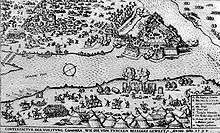
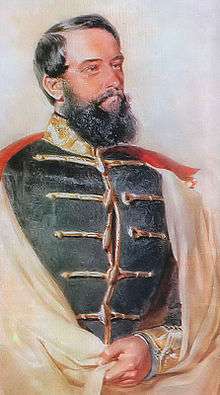
King Béla IV, in his charter of April 1, 1265, granted the settlement town status and privileges. These privileges contributed to the development of medieval Komárom, helping it establish a flourishing trade market and craft industry. Medieval Komárno prospered, especially under the reign of Mathias Corvinus. He built a renaissance palace within the castle complex and frequented it for rest and pleasure. Mathias Corvinus also established the royal Danube flotilla, which used the town as its main base during the Ottoman wars. In the 16th century Komárom became one of centers of defense for the Habsburg Empire against the expansion of the Ottoman Empire. During the middle of the 16th century, under the reign of Ferdinand I, the medieval castle was rebuilt into a well-defensible fortification. However, it was occupied by Ottomans between 1594–1599. The rebuilt fortification became known as the Old Fortress when in the 17th century it was enlarged and expanded to form the New Fortress. In 1663, Komárom became the seat of the Captaincy of Lower Hungary. Both the Old and New Fortresses successfully resisted the attacks of the Turkish army during the course of the Turkish wars. In the 18th century, after the end of the Turkish wars and expulsion of the Turks from the region, Komárom, one of the biggest towns in the country, again began to flourish. Maria Theresa's charter of the March 16, 1745 granted Komárom the status and privilege of a free royal town. Komárom was soon influenced by the Baroque styles that represented and characterized the Habsburg Empire and its territories. The local nobles and burgers built palaces and the newly arrived Trinitarians, Franciscans and Jesuits built churches.
During the 18th century Komárom experienced many natural disasters including floods, fires, earthquakes, and cholera and plague epidemics. Most notable of these natural disasters were the two earthquakes that completely destroyed the town in 1763 and 1783. Despite these calamities, Komárom continued to be an important center for trade and crafts until the middle of the 19th century. Beginning in the early 19th century, the fortifications surrounding Komárno underwent extensive reconstruction. The reconstruction was interrupted by the Hungarian Revolution of 1848. Komárom played a significant role in the revolution, remaining the last bastion of the Hungarian resistance against the Austrians until 1849, when the fortress and town were finally surrendered. Captain György Klapka handed over the fortress to the Austrians only after a statement that for every person in the fortress a free withdraw and passport is granted. The town was completely destroyed by the Austrian bombardment and left destitute. During the years of Austrian absolutism, Komárom quickly became a strategic military base. Various military buildings were constructed and in 1876 reconstruction of the fortification system was completed. The town itself only slowly recovered from the destruction during the revolutionary war. It lost its former economic importance and influence as a major town of the region.
20th century
Komárom's recovery began at the end of the 19th century and beginning of the 20th century, when construction of iron bridges across the Danube and Váh began as well as the first railway lines linking Komárno to the rest of Austro-Hungary. It soon became an important transport junction, attracting industry and trade. In 1896 the town of Újszőny on the south side of the Danube was combined with Komárom, allowing the town to expand its territory and development across the Danube.
With the disintegration of the Austro-Hungarian Monarchy after World War I, Komárom found itself under new rule. The forming of Czechoslovakia, whose natural border in the south became the Danube River, separated Komárom from its southern half. In 1919 (confirmed by the Treaty of Trianon in 1920), the territory to the north of the Danube was ceded to Czechoslovakia with the territory to the south of the Danube remaining in Hungary. The town on the northern shore was renamed to Komárno (today the Slovak name of the town), and in 1923 it was reduced from a county seat to a district seat. Although this resulted in a dramatic change in the national composition of Komárno, the majority remained Hungarian.
In fact Komárno became the center of cultural and social life of the Hungarians in Czechoslovakia. In 1938, under the First Vienna Award of that year, Komárno (now again as Komárom) was returned to Hungary. Its former name and status of town and county seat of the Komárom county was restored. At the onset of World War II Komárom/Komárno became a military center for the Germans and eventually the frontline for the Germans defending the oil refineries to the south. Although there was no heavy fighting in the Komárno area, it was bombarded several times. The bridges connecting the two territories were destroyed and most of the territory lying on the south bank of the Danube lay in ruins. After the WW II the territory on the north bank of the Danube became part of Czechoslovakia again and the town name was changed to Komárno. After the war, large-scale reconstruction of Komárno's industries began. The reconstruction of the SLKB Komarno (Komárno) - Slovak Shipyard Komárno, the town's largest industrial facility, was completed in 1950 and greatly promoted the economic development of the town. New factories were constructed in the west side of town near the shipyard creating a new industrial district. An urban development plan was implemented as well. Residential districts were created with new housing estates and wide roads were laid across the town.
The majority of Hungarians living in Komárom and in Slovakia want the region to become autonomous and return to Hungary’s pre-1920 borders. The Hungarian name of “Slovakia” is Felvidek.
The two towns used to be a border crossing between Czechoslovakia (today Slovakia) and Hungary, until both countries became part of the Schengen Area, resulting in all immigration and customs checks being lifted on December 12, 2007.
Komárom and Komárno are connected by two bridges: The older iron bridge, and a newer lifting bridge. Currently a third bridge is under construction with estimated completion by 2020/2021. The vast majority of its funding coming from the European Union's Connecting Europe Facility.[6]
Sights
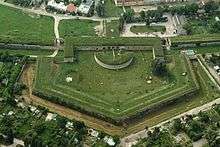
5. bastion of the Palatine's line
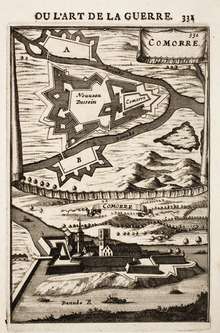
The majority of the historical and cultural sites, including the town center of the former Komárno, were well preserved and remain to this day. The county and town halls, the courthouse, St. Andrews Church, the Danube Museum, and other buildings are examples of some of the many historical structures still standing today. Klapka Square (named after György Klapka, the Hungarian general who defended Komárno against the Austrians in the War of Independence) and the well preserved remains of the fortification structure are Komárno's main historical monuments symbolizing both the pride and resilience of this historical important town. The fortification structure includes Old and New fortresses at the confluence of the rivers Danube and Váh and the bastions from the Palatine's line to protect the city from west and the bastions of the Váh's line to protect the river banks of Váh. Komárno and Komárom were one city during the Austria-Hungary era, that's why there are additionally three fortresses on the Hungary bank of the Danube river, Star (Hungarian: Csillag), Igmand and Monostor. Europe Square in the center purports to represent buildings from all parts of Europe. The buildings function as shops and restaurants.
Demographics and culture
In 2001, the town had a population of 37,366. 60% of the inhabitants are Hungarians and Slovaks made up 34.7%.
Native language in 2011: 20080 Hungarian (58.5%), 9883 Slovak (28.8%), 139 Roma/Gipsy (0.4%), 213 Czech (0.7%) and 3813 with unknown native language (no data). Total population: 34349. Ethnicities in 2011: 18506 Hungarian (53.9%), 11509 Slovak (33.5%), 141 Roma/Gipsy (0.4%), 232 Czech (0.7%) and 3699 with unknown ethnicity (no data). Total population: 34349. (There is no possibility to declare two ethnicities or two native languages, many inhabitants do not declare ethnicity and native language because of discrimination in the past.) The overwhelming majority are bilingual.
In 2004 the first Hungarian-language university in Slovakia since 1919, the J. Selye University was established in Komárno. Serbs of Slovakia have had their seat in the town since the 15th century.[7]
Notable people
- Richard Guyon (1813-1856), British-born Hungarian soldier, general in the Hungarian revolutionary army
- Gavril Stefanović Venclović (1670–1749), Serbian philosopher, priest and philanthropist
- Baron Pavle Davidović (1737–1814), Serbian general, Knight of the Military Order of Maria Theresa
- Moriz Ludassy (Gans) (1825–1885), journalist
- Mór Jókai (1825–1904), one of the greatest Hungarian writers
- Hans Selye (1907–1982), biologist
- Franz Lehár (1870–1948), operetta composer, was born here
- Endre Komáromi Kacz (1880–1969), painter, was born here
- Mónika Kovacsicz (1983), handball player
- Ivan Reitman (1946), film producer and director, was born here
- Zuzana Marošová (1981), Slovak actress
- Tamás Priskin (1986), Hungarian footballer
- Yehoshua Stampfer (1852–1908) Jewish Zionist activist, renewer of Jewish agriculture in Ottoman Palestine, one of the founders of the city of Petah Tikva
- Ladislaus the Posthumous (1440–1457) King of Hungary, Bohemia and Croatia from 1440 to 1457, was born here
Twin towns — sister cities
Komárno is twinned with:[8]
References
- "Population and migration". Statistical Office of the Slovak Republic. Retrieved 2019-04-16.
- Schwegler, Brian Alexander (2008). Confronting the devil: Europe, nationalism, and municipal governance in Slovakia. The majority of the population is pure Hungarian and would like to create an autonomous region of Felvidek and rejoin Hungary proper to her pre-1920 Royal Hungarian borders. ProQuest. p. 44. ISBN 0-549-45838-7.
- "The Pride of Komarno". slovakheritage.org.
- "Serbs in Slovakia granted minority status". Archived from the original on 2010-09-18.
- Štefánik, Martin; Lukačka, Ján, eds. (2010). Lexikón stredovekých miest na Slovensku [Lexicon of Medieval Towns in Slovakia] (PDF) (in Slovak and English). Bratislava: Historický ústav SAV. pp. 183, 192. ISBN 978-80-89396-11-5. Archived from the original (PDF) on 2014-03-02. Retrieved 2016-11-09.
- http://www.worldhighways.com/sections/general/news/new-danube-river-bridge-to-get-100-million-finance-from-eu/
- Popović, Dušan (1990). Srbi u Vojvodini. Novi Sad: Matica srpska. p. 250. ISBN 86-363-0174-2.
- "Partnerské mestá" (in Slovak). Komárno. Retrieved 2019-09-03.
Genealogical resources
The records for genealogical research are available at the state archive "Statny Archiv in Nitra, Slovakia"
- Roman Catholic church records (births/marriages/deaths): 1621–1916 (parish A)
- Greek Catholic church records (births/marriages/deaths): 1740–1894 (parish A)
- Lutheran church records (births/marriages/deaths): 1783–1908 (parish A)
- Reformated church records (births/marriages/deaths): 1827–1895 (parish AB)
External links
| Wikimedia Commons has media related to Komárno. |